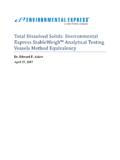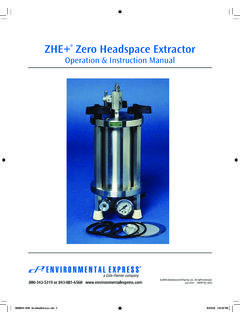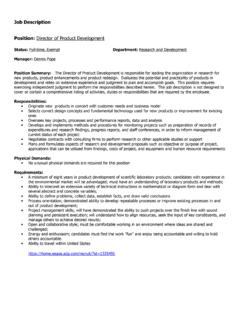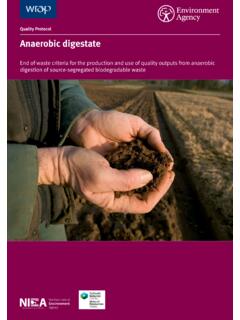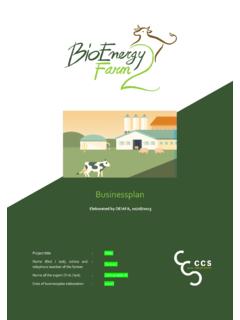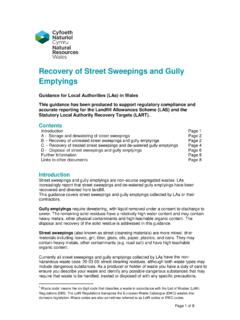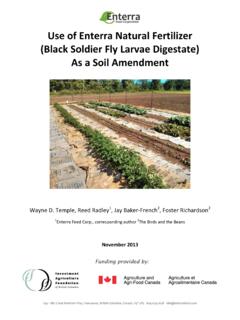Transcription of Total Kjeldahl Nitrogen (TKN) FAQs - Environmental …
1 2345A Charleston Regional Pkwy, Charleston, South Carolina 29492 843-881-6560 800-343-5319 843-881-3964 (Fax) Total Kjeldahl Nitrogen (TKN) FAQs Why is TKN important? The Nitrogen cycle is the means by which atmospheric Nitrogen is made available in various forms to living organisms. From the basic molecules of ammonia, nitrate, and nitrite to the more complex amino acids and proteins, Nitrogen is essential for living organisms to function. It is also an important part in the smooth operation of many wastewater treatment plants. In order for the cycle to operate smoothly it is vital to know the amount of Nitrogen contained in the various phases of the cycle. TKN analysis provides the opportunity to quantify the amount of Nitrogen contained in organic form. What are the approved TKN methods? The TKN analysis has two options: Digestion followed by distillation and analysis according to an approved ammonia method: o SM 4500-Norg B-1997 or C-1997 o ASTM D3590-02(06) (A) o USGS I-4515-91 Digestion followed by direct analysis of the digestate: o EPA (Rev.)
2 1978) o EPA Rev. (1993) o SM 4500-Norg D-1997 o ASTM D3590-02(06) (B) o USGS I-4515-91 How do these methods work? The sample is heated in a mixture of sulfuric acid, potassium sulfate, and a metal catalyst. This converts organic Nitrogen and free ammonia to ammonium. The digestate can then be distilled for the separation of ammonia and analyzed colorimetrically, via ISE, or titration. Alternatively, the digestate can be analyzed directly via a modified Berthelot reaction. What is the digestion solution catalyst? Traditionally mercury has been used in this reagent. The EPA is now encouraging labs to use an alternative copper based digestion solution. The EPA method gives mercury as the primary catalyst with the option to use copper as an alternative. Standard Methods, on the other hand, only has the option to use copper.
3 Using copper will help eliminate or reduce a hazardous waste stream in your lab. 2345A Charleston Regional Pkwy, Charleston, South Carolina 29492 843-881-6560 800-343-5319 843-881-3964 (Fax) Total Kjeldahl Nitrogen (TKN) FAQs Do the methods accurately measure all Nitrogen in all organic compounds? Because there are a large variety of organic compounds which contain Nitrogen , a single test cannot be formulated that will cause each one to respond in an equal manner. The digestion serves to overcome that issue by converting all target Nitrogen forms to a single compound, namely ammonia. This allows for all the Nitrogen to be analyzed as one species. Unfortunately, qualitative analysis is not possible. The results must be expressed simply as TKN. TKN digestion will only give you results of the Total organic Nitrogen plus ammonia.
4 TKN is usually requested to gain knowledge as to the Total Nitrogen content of the sample. Thus the other Nitrogen analyses are often run as well. The relationships are given below. = + ( + ) = = ( + ) + = + What are some of the interferences in TKN analysis? There are a few interferences to keep in mind when doing a TKN digestion. The first is actually an additional Nitrogen source, but it is not included in TKN. Nitrate in excess of 10 mg/L can have varying degrees of interference with the sample digestion.
5 Nitrate can interfere negatively by oxidizing a portion of the ammonia to N2O, thereby reducing the amount recovered by the digestion. Nitrate can also have a positive interference effect if low oxidation state organic matter is present in sufficient amounts. In this case the nitrate can potentially be reduced and form ammonia. Both of these interactions are poorly understood and the exact amounts and rates of formation are insufficiently characterized to make corrections possible. How do inorganic compounds affect TKN? Inorganic species can also cause problems with TKN digestion. These however are more easily addressed. High amounts of dissolved inorganic salts may cause the digestion temperature to exceed 400 C. At this temperature the heat can cause the Nitrogen compounds to decompose and release Nitrogen gas directly.
6 To overcome this issue you may add 1 mL H2SO4/g salt present in the sample. Always be sure to add equivalent amounts to any blanks. Do not routinely add excess H2SO4 without first knowing that it is necessary. Too much acid will lower the digestion temperature to the point that the digestion will be incomplete. If the samples are distilled after digestion, this interference as well as its solution poses additional problems. High concentration of salts can cause bumping in the solution during distillation. Add extra reagent water to the digestate to reduce the salt concentration. Also, treating with additional acid will require more neutralization prior to distillation. 2345A Charleston Regional Pkwy, Charleston, South Carolina 29492 843-881-6560 800-343-5319 843-881-3964 (Fax) Total Kjeldahl Nitrogen (TKN) FAQs How do I address the acid fumes generated during the TKN digestion?
7 The TKN digestion is a very harsh process. The acid fumes that are generated will cause significant corrosion over time in the area where this is performed. Some systems have a scrubber system that will remove many of those vapors while others utilize tear drop glass stoppers or other surface condensers to condense the acid fumes back into the tubes. These all have varying degrees of success but none will protect the area completely. How are samples analyzed after digestion? After digestion TKN samples can be analyzed directly or distilled as an ammonia sample. Analysis of the TKN digestate directly via colorimetric means has one very important item to keep in mind. The solubility of salicylate is very pH dependent. If you use a discrete analyzer or a manual procedure, the order of adding the reagents is especially important, as is the necessity of mixing the solution well after each reagent addition.
8 If using a flow injection system, the buffer must be allowed to flow completely through the board prior to placing the line for the salicylate reagent in solution. Conversely, the buffer should always be the last reagent line removed and flushed and should only be done after all other lines have completely flushed out. While one would always try to avoid running out of reagent or having air bubbles present in the lines, these could be especially disastrous with TKN analysis. Failure to buffer the solution at the appropriate pH will not only cause problems with the color development of the test, as in most colorimetric procedures, but will also result in the salicylate falling out of solution. In a flow injection system this would be a major headache. The small bore of the tubing used will be completely plugged and it will nigh unto impossible to redissolve the salicylate crystals.
9 All the tubing containing the precipitate will have to be replaced. Do I need to use boiling stones when digesting? Proper boiling stones are an absolute necessity when performing a TKN digestion, especially when using the 75-100 mL digestion vessels that are now more common. Failure to add the boiling stones will cause your samples to superheat and flash boil. Standard Methods recommends glass beads and EPA says to use Teflon chips. Neither of these are the best option to use as they both tend to have a very smooth surface that provides insufficient nucleation sites. Carbon chips provide a rough surface however they tend to break down under the digestion conditions. Hengar boiling stones will consistently stand up to the harsh reagents and will provide an adequate surface for nucleation to occur. Boiling stones that have been treated with a metal, such as selenium, for a catalytic effect are not necessary and add an avoidable expense.
10 Along these same lines, be sure to limit the amount of sample being digested to about 25% of the capacity of the digestion vessel. The temperature and acid used will cause vigorous boiling and foaming in the vessel. You will need to have sufficient headspace to contain the reaction. 2345A Charleston Regional Pkwy, Charleston, South Carolina 29492 843-881-6560 800-343-5319 843-881-3964 (Fax) Total Kjeldahl Nitrogen (TKN) FAQs What is the method procedure? Note This is not intended to be a standalone method and does not address all safety or quality control aspects that may be required. Please consult your local regulations to comply with all requirements. 1. Collect your sample in an appropriate sized glass or plastic sampling container and preserve with sulfuric acid to a pH of less than 2. 2. Add 25 mL of the sample (other volumes may be used, adjust the amount of digestion solution appropriately) to the digestion tube.

